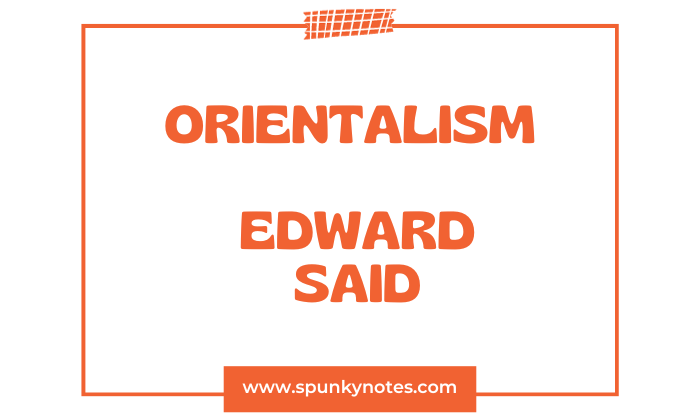
Q. Explain the concept of Orientalism by Edward Said.
Orientalism
Edward Said’s book, “Orientalism,” made a significant impact in the 20th century. It changed how people think about the relationship between the West (like Europe and the U.S.) and the East, often called the Orient (a term historically used by the West to describe these regions).
Said argues that how the West sees the East is not just a natural view. Instead, it is shaped by Western cultures and their ideas. He says that Westerners themselves create the image of the East in Western minds.
This idea was groundbreaking. It made people realize that their culture’s beliefs and biases can influence their understanding of different parts of the world.
Said’s book opened up new ways of thinking about how different cultures see and understand each other, especially how powerful countries or cultures can shape the image of other places.
What is Orientalism?
Orientalism is a term that primarily refers to the way Western cultures view, interpret, and represent the cultures of the East, particularly the Middle East, Asia, and North Africa. Edward Said notably defined and critically analyzed it in his 1978 book, “Orientalism.”
In his work, Said describes Orientalism as a pervasive Western tradition, both academic and artistic, of prejudiced outsider interpretations of the Eastern world.
These interpretations are often based on stereotypical images and ideas rather than genuinely understanding these cultures.
According to Said, Orientalism in Western thought creates a distinction between the “Orient” (East) and the “Occident” (West), suggesting that Eastern societies are exotic, backward, uncivilized, and at times dangerous, in contrast to the rational, developed, and superior West.
Orientalism, therefore, is not just a set of mistaken assumptions about the East. It is a broader cultural and ideological tool used historically to justify Western political and economic dominance over Eastern societies.
This concept has had significant influence in literary criticism, cultural studies, and postcolonial studies, highlighting how power and knowledge are intertwined in the representations of different cultures.
What is the Orient?
Edward Said says the Orient is a “semi-mythical construct” imposed on East European countries.
A “semi-mythical construct” refers to an idea or concept partly based on reality but shaped mainly by myths, stereotypes, or fictional narratives.
It means that while the Orient (referring to regions in the Middle East, North Africa, and parts of Asia) is an actual geographical entity with genuine cultures and societies, the way it has been understood and represented in the West is heavily influenced by imaginative, exaggerated, or false perceptions.
These perceptions or constructs are “semi-mythical” because they blend some elements of truth with significant myth-making.
Construction of the Orient
According to Said, the Orient (referring broadly to the Middle East, Asia, and North Africa) is not just a geographical location but a construct shaped by Western attitudes, prejudices, and interests.
This construct is “semi-mythical” because it is based partially on reality but primarily on imagined ideas and stereotypes about Eastern societies.
Exoticism and Fantasy
Western depictions of the Orient often lean heavily on elements of exoticism and fantasy. The stories from “One Thousand and One Nights,” including Aladdin, are prime examples.
While culturally significant, these tales were embraced in the West for their exotic and fantastical elements, often without a deeper understanding of their cultural contexts.
Mysticism and Irrationality
Mystic poetry and other forms of Eastern literature and art have been interpreted in the West through a lens that emphasizes mysticism and irrationality.
It aligns with the stereotype of the Orient as a place of timeless wisdom but also of irrational and unscientific thinking, in contrast to the “rational” and “progressive” West.
Stereotypes and Generalizations
The “mythical” aspect of the Orient includes generalizations and stereotypes. For example, Eastern societies are often depicted as timeless, unchanging, and trapped in antiquated traditions.
Western views often oversimplify the East. They reflect more on Western fantasies and fears than on the diverse realities of Eastern regions.
Role of Power and Imperialism
Said argues that this construction of the Orient served the political purposes of European imperialism. By portraying Eastern societies as fundamentally different, exotic, backward, or even inferior, European powers justified their colonial and imperialist ambitions as a civilizing mission.
Who are Orientalists?
They are scholars, writers, and artists in the West who specialize in studying and representing the “Orient. These scholars can be historians, linguists, and researchers specializing in various aspects of the East, including its languages, history, religions, art, and social structures.
Writers
Some Orientalists are writers and authors who produce books, essays, and articles that explore and describe Eastern cultures. Their writings can range from travel literature to scholarly publications.
Edward William Lane (1801–1876). He wrote about how Egyptians lived in the 1800s and translated “The Thousand and One Nights” into English.
Gustave Flaubert (1821–1888). He travelled to Egypt in the 1800s and wrote about his experiences, giving Western readers a view of Egypt at that time.
Ella C. Sykes (1863–1939). She explored places in the Middle East and Central Asia in the late 1800s and early 1900s and wrote about her journeys, sharing her experiences with readers.
Artists
Orientalist artists use various mediums, such as painting, sculpture, and visual arts, to depict scenes, landscapes, and people from the East.
Their artworks often romanticize or idealize Eastern themes, showcasing exotic imagery and cultural elements.
Jean-Léon Gérôme (1824–1904). He was a famous French academic painter known for his detailed Orientalist paintings. Gérôme’s artworks often depict scenes from the Middle East and North Africa.
John Frederick Lewis (1804–1876). A British artist specializing in Orientalist themes, Lewis is renowned for his paintings that captured the Middle East’s daily life, architecture, and costumes, particularly in Egypt.
Eugène Delacroix (1798–1863). While primarily known as a Romantic artist, some of his works show Delacroix’s fascination with the Orient. His famous painting “The Women of Algiers” is a prime example of Orientalist art.
What is the Occident?
The term “Occident” refers to the Western world, especially in contrast to the ‘Orient.’
The Occident, commonly known as the Western world, includes regions like Europe and the Americas. It represents a set of cultural, political, and social norms and values that have historically been contrasted with those of the Orient or Eastern regions like Asia and the Middle East.
The term “Occident” symbolizes not just a geographical area but a collective mindset shaped by Western philosophies, scientific advancements, and democratic principles.
It often implies a sense of modernity and development. In historical and cultural studies, the Occident highlights the differences and interactions between Western and Eastern societies, particularly regarding cultural perceptions, governance, and lifestyle.
Contrasting Stereotypes: Orient vs Occident
| Orient (The East) | Occident (The West) |
|---|---|
| Backward Often depicted as lagging in technological and societal advancements. |
Progressive Leaders in technological and social development. |
| Uncivilized Lacking in modern cultural and social norms. |
Civilized Possessing advanced cultural and social structures. |
| Unscientific Associated more with tradition and mysticism than with empirical science. |
Scientific Credited with rational, scientific thinking and technological innovations. |
| Exotic Exotically romanticized in art and literature, creating a sense of mystique and otherness. |
Rational Associated with logical thinking and Enlightenment values. |
| Static Resistant to change and stuck in ancient ways. |
Dynamic Constantly evolving, innovative, and forward-moving. |
| Despotic Often portrayed as having oppressive, autocratic governments. |
Democratic Often portrayed as upholding freedom, democracy, and individual rights. |
Understanding Edward Said’s Book ‘Orientalism’
Western Conception of the Orient
In his book Orientalism, Edward Said discusses how the West, including Europe and America, thinks about the East, which he calls the Orient.
He says that the picture the West has of the East is not just something that naturally happened. Instead, people in the West created this picture based on their ideas and beliefs. Said explains that this view of the East is not really about how the East is but more about how the West imagines it.
This way of thinking has become a big part of Western culture and has affected how people in the West study and talk about Eastern societies.
So, the East that many people in the West understand is not a true reflection of the real East but more of a creation of the Western mind.
Academic Orientalism
In “Orientalism,” Edward Said describes how the study of the East, or Orientalism, became a significant subject in Western education. He explains that Western universities and scholars started to study and teach about Eastern cultures and societies.
However, there is a twist. Said points out that Western ideas and opinions heavily influenced how they studied the East. It means that instead of truly understanding the East, they often created a version of the East that matched what they already thought or wanted to believe.
This kind of study became very popular in Western academic circles. However, it was not always an accurate or fair representation of Eastern societies. It was more about how the West viewed the East rather than how the East is.
Critique of Orientalism
In “Orientalism,” Edward Said critiques how the West studies and portrays the East. He argues that this Western view, called Orientalism, is biased.
It often shows Eastern societies in a way that’s not true to their actual nature. Instead, these views are shaped by Western stereotypes and past colonial attitudes.
Said points out that this creates an unfair power balance. The West, being assertive and influential, gets to define how Eastern societies are seen and understood.
It is not just in academic studies but also in movies, books, and news. As a result, the East is often shown as exotic, mysterious, or even backwards compared to the West. It can lead to misunderstandings and prejudices in the West about Eastern people and cultures.
Orientalism in the 20th century
In the 20th century, the way the West viewed the East, known as Orientalism, changed slightly but still had issues. Edward Said explains that the world saw significant political and social changes.
These changes affected how Western countries interacted with and thought about Eastern countries. However, the basic idea of Orientalism, where the West often sees the East through its ideas and prejudices, stayed pretty much the same.
Said points out that even with new technology, media, and ways of sharing information, the old thinking patterns about the East did not go away.
They just showed up in new forms. For example, Western movies, news, and books continued to portray Eastern cultures in a way that matched Western ideas more than the real cultures of the East. It means that the problem of Orientalism, with its stereotypes and biases, continued well into the 20th century.
Conclusion
Edward Said’s “Orientalism” is a powerful book that challenges how the West views and understands the East. Said shows that this view is often shaped by Western ideas and biases rather than being a true reflection of Eastern societies.
His book made people think differently about cultural relationships and power dynamics between the West and the East. It is vital because it highlights how stereotypes and biases influence our understanding of different cultures.
Even today, “Orientalism” remains relevant. It encourages us to be more aware of and question our perspectives, especially when learning about different cultures.
The book reminds us of the importance of looking at other cultures with an open and fair mindset, which is crucial in our interconnected world.

